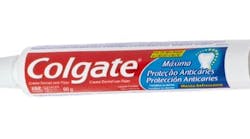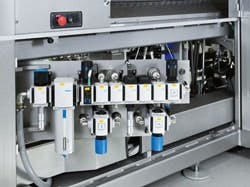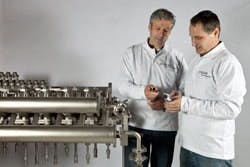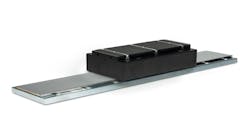With Colgate-Palmolive increasing its share of the global toothpaste and toothbrush market to almost 45% recently, its no wonder that it needs to fill toothpaste tubes faster and more efficiently than ever.
Oystar IWK Verpackungstechnik in Stutensee, Germany, rose to the challenge, revving up the output of its tube-filling machine by almost 50% and adding measures to reduce overfilling as well.
New Technology Answers the Call
With a pulse frequency of 94 cycles/min, Oystar's eight-part TFS 80-8 machine fills and closes 750 28 mm diameter tubes a minute, or 45,000 tubes an hour (Figure 1). That's up from 510 tubes a minute for the company's previous machine, the TFS 80-6. And it's accomplished in a similar footprint to the TFS 80-6.
Figure 1: The TFS 80-8, showing the internal transport system in the foreground, fills 750 toothpaste tubes in a minute, almost 50% faster than its predecessor.
Source: Oystar IWK
The dual-circuit pneumatic design of the TFS 80-8 sees to it that tubes are fed in accurately, and is used primarily for safety reasons, notes Andreas Siegele, head designer at Oystar IWK. The robot hand and the box feed operate independently of each other. A valve terminal controls all the pneumatic drives of the machine, while the input modules of the terminal process all the sensor signals (Figure 3). Both the CPX/MPA valve terminals as well as MS-6 series exhaust valves, all made by Festo, have long been defined as the standard by the Oystar Group.
Air SafeSource: Oystar IWKPneumatic Control
Source: Oystar IWK
Correctly Positioned and Filled
Advances to Oystar's tube filler come not only in the form of speed, but accuracy as well. Besides increasing output by nearly 50%, the new machine reduces overfilling of the tubes by precisely checking its weight.
In the first step of the process that leads to a perfect tube of toothpaste, a robot feeds the empty tubes, which are open at the bottom, to the tube holder. The next step transports the tubes safely through the machine. A high-resolution camera checks the edge of the tube for possible defects, and another camera watches as the tube is opened with compressed air.
Using a printed mark, the TFS 80-8 precisely aligns the tubes. It ensures that the tube remains in the correct position during the work process and keeps a stable shape when it is filled. If the alignment is not right, the printed design could be askew or shifted when the tube is closed later. So that each tube is allocated to the correct product batch, the machine reads the code again at the same station. This enables customers to clearly see where a tube delivery came from or on which day it was filled.
If a production error occurs — or rather, if a predefined number of errors are reached in a specific operating period — the machine stops and the operators look into the source of the error. Reject tubes are clearly identified and do not impair the overall quality of the batch.
Weighty Filling Considerations
The filling module distributes the toothpaste inside the tube. A 3/2-way directional control valve sucks in the correct volume, redirects it, and discharges it. A plunger opens the filling pipe, the toothpaste flows into the tube, the filling pipe closes again, and the plunger cuts off the toothpaste.
Ensuring improved filling accuracy with the latest machine model, each filling point has a pair of scales that supply data reliably to the machine controls. This avoids overfilling because the precise amount of toothpaste in each tube can be specified and checked (Figure 4).
This could mean a savings of 83,000 kg of toothpaste in just one year. "There are filling weight deviations in all filling processes," Siegele notes. "Only with the help of a 100% entry/exit weighing of the tubes and the information to the piston stroke can the overfill be reduced."
Oystar has also applied the weight-check technology to earlier models of the filling machine, according to Siegele. "While developing the means of checking weight for the TFS 80-8, we also developed an inline weighing for the TFS 80-6," he says. "Existing machines can be retrofitted."
After it has been accurately filled, the open edge of the tube is heated with hot air. Not only must the hot air not come into direct contact with the toothpaste, it also cannot have a negative thermal effect on the aluminum separating layer because it could cause the tube to leak. When the material temperature reaches the right range, a press closes the tube and embosses the tube seam. At the cutting station, the end of the tube is neatly cut.
Precision ExpertsSource: Oystar IWKWeigh Before Away
Source: Oystar IWK
Final Quality Steps
At a station further down the line, the TFS 80-8 discards any reject tubes. The good tubes travel on to the discharge point, where they are ejected from the holder and rotated 180°. After they have been weighed again (Figure 5), the machine places the finished toothpaste tubes onto the continuously running product chain of the next machine in the line, the SC 3-800 cartoning machine. This is a critical point in the manufacturing process because the machine changes from a cyclical mode to a continuous one. Particularly critical is the design of the mechanical components because at this point very high acceleration rates occur and high masses are moved.
At the filling rates Oystar has managed to achieve with its latest machine, acceleration rates are tricky, Siegele says. "The key challenges come from the high inertial forces due to the acceleration of 94 cycles/min," he says. "The process time for filling, closing, tube picking to the unit weigher, with camera controls, is very short."
At the end of the line, folding boxes are automatically opened up, aligned and brought up to the same speed as the tubes that are running in parallel with them. A special pusher finger pushes them gently into the packaging.
Although the main functions — including tube print registration, filling, closing and movement while tube picking — are equipped with electro servo drives, pneumatics are needed for the tube handling, such as sucking up the tubes to the tube picking unit weigher. "Electric actuators for moving the robot hand are too heavy; therefore, we have used pneumatics," Siegele says. "The robot can only move a limited weight of the hand within the required cycle time."
With the TFS 80-8, Oystar has nearly reached the physical limits for speed in an indexed machine in order to ensure production safety of the machine in a three-shift operation, Siegele says. "In future, we will work on enlarging the format range," he says, explaining that the TFS 80-8 cannot yet handle 40 mm diameter tubes like the TFS 80-6 can.










